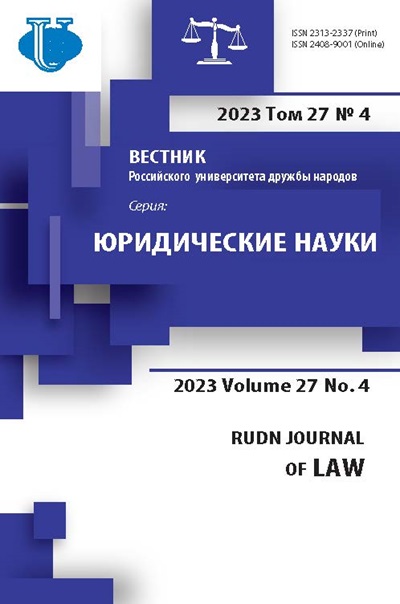Criminal responsibility for crimes against children in USA
- Authors: Nagornaya I.I.1
-
Affiliations:
- National Research University Higher School of Economics (HSE University)
- Issue: Vol 27, No 4 (2023)
- Pages: 1007-1027
- Section: CRIMINAL LAW AND CRIMINOLOGY
- URL: https://journals.rudn.ru/law/article/view/36900
- DOI: https://doi.org/10.22363/2313-2337-2023-27-4-1007-1027
- EDN: https://elibrary.ru/MXTMJZ
- ID: 36900
Cite item
Full Text
Abstract
Children require special legal protection, including criminal law protection, in all countries since they are one of the most vulnerable categories of population. Crimes against children inflict harm not only to victims but also affect further development of society as a whole. The US experience in the field of criminal law protection of children has significant specifics and is of scientific interest. The purpose of this paper is to identify and describe characteristic features of American criminal law in this area and its applicability in Russia. To reach the goal formal-legal, comparative-legal and other methods are used. American laws create legal duty to report acts that constitute child abuse. Failure to report constitutes crime. Statutes of several US states contain special chapters devoted to crimes against children. Parents or other caregivers may not inflict harm the child directly but also, by inaction, allow third party to do so. Such inaction is deemed a crime. Using reasonable force to discipline children is legal in the USA if the punishment does not inflict harm greater than transient pain and other legal requirements are met. Parents or other caregivers must control children and never leave them unattended at home if they are younger than state`s law or recommendations of state`s authorities prescribe. «Hot car» laws prohibit to leave children unattended in a vehicle if they have not reached the age prescribed by law. Violation of such duties is a crime in some cases. The applicability of such experience in Russia is analyzed for each criminal law prohibition. It is concluded that many rules of the US criminal law are redundant. The features that are of certain interest for our country have been identified and studied.
About the authors
Irina I. Nagornaya
National Research University Higher School of Economics (HSE University)
Author for correspondence.
Email: irnag@yandex.ru
ORCID iD: 0000-0002-8423-3754
SPIN-code: 6087-4020
Candidate of Legal Sciences, Associate Professor of the Department of Criminal Law, Legal Process and Criminalistics
20 Myasnitskaya str., Moscow, 101000, Russian FederationReferences
- Artemyeva, Y.A. & Sergeeva, V.V. (2019) Problems of determining child support obligations in Russian and American. Utopía y Praxis Latinoamericana. 24 (5), 429-439.
- Austin, A., Lesak, A. & Shanahan, M. (2020). Risk and protective factors for child maltreatment: A review. Injury epidemiology. 7(4), 334-342. https://doi.org/10.1007/s40471-020-00252-3
- Ben-David, V., Jonson-Reid, M., Drake, B. & Kohl, P. (2015) The association between childhood maltreatment experiences and the onset of maltreatment perpetration in young adulthood controlling for proximal and distal risk factors. Child abuse & neglect. (46), 132-141. https://doi.org/10.1016/j.chiabu.2015.01.013
- Dedel, K. (2010) Child abuse and neglect in the home: problem-oriented guides for police. Tempe, Center for Problem-Oriented Policing.
- Edwards, L. (1996) Corporal punishment and the legal system. Santa Clara law review. 4(36), 983-1023.
- Fedotov, A.V. (2012) The average person fiction in Russian criminal law. Part 1. Moscow, Yurlitinform Publ. (in Russian).
- Funderburk, C. (2013) Best interests of the child should not be an ambiguous term. Children`s legal rights journal. 33(2), 229-266.
- Jacobs, M.S. (1998) Requiring battered women die: murder liability for mothers under failure to protect statutes. Journal of criminal law and criminology. 88(2), 579-660.
- Jennissen, C., Evans, E., Oral, R. & Denning, G. (2018) Child abuse and neglect experts' determination of when a child being left home alone constitutes child neglect. Injury Epidemiology. 5(16), 55-62. https://doi.org/10.1186/s40621-018-0144-0
- LaFave, W.R. (2010) Criminal law. 5th edition. Thomson Reuters, West Academic.
- Lee, K.A. & Douglas, E.M. (2021) An exploratory study of the prosecution of fatal child maltreatment: Criminal charges filed against presumed perpetrators in the United States in 2017. Violence & victims. 5(36), 638-650.
- Loewy, A.H. (2009) Criminal law. Thomson Reuters.
- Liu, B. & Vaughn, M. (2019) Legal and policy issues from the United States and internationally about mandatory reporting of child abuse. International journal of law and psychiatry. (64), 219-229. https://doi.org/10.1016/j.ijlp.2019.03.007
- Mahoney, A. (2019) How failure to protect laws punish the vulnerable. Health matrix: the journal of law-medicine. 29(1), 429-461.
- Nagornaya, I.I. (2017) Child abuse as estimating concept of criminal law. Pravo. Zhurnal Vysshey shkoly ekonomiki. (2), 142-154. https://doi.org/10.17323/2072-8166.2017.2.142.154 (in Russian).
- Reed, J.G. (2004) Maltreatment of children: an American perspective. The Journal of social policy studies. 2(2), 265-282. (in Russian)
- Schnitzer, P., Covington, T., Kruse, R. (2011) Assessment of caregiver responsibility in unintentional child injury deaths: challenges for injury prevention. Injury prevention. 17, 45-54.
- Stanziani, M. & Cox, J. (2021) The failure of all mothers or the mother of all failures? Juror perceptions of failure to protect laws. Journal of interpersonal violence. 36(1-2), 690-711. https://doi.org/10.1177/088626051773627
- Vandervort, F. (2020) The law and policy of child maltreatment. Handbook of interpersonal violence and abuse across the lifespan. In: Geffner, R. et al., (eds.). New York, Springer International Publishing.
- Vitiello, M. (2010) Defining the reasonable person in the criminal law: fighting the lernaean hydra. Lewis & Clark law review. 14(4), 1435-1454.
Supplementary files















